L.L. Diamond's Blog, page 15
December 18, 2017
Rome – The Colosseum and the Arch of Constantine
[image error]In 64AD after the fires in Rome, the Emperor Nero decided to build himself a palace that would be called The Golden House. Upon Nero’s death, Rome was engulfed in a civil war until Vespasian took the throne in 69AD. Instead of building a monument of palace for himself, he decided to build an amphitheatre for the people to enjoy, erecting it on the lake of Nero’s palace. Construction began in 72AD, but the huge structure wasn’t completed until 80AD when Vespasian’s son Titus was emperor. The finished structure was capable of holding 50,000 people, making it the largest of its kind in the Roman Empire.
Over the years, the Colosseum was plundered for multiple reasons–the wealthy as well as the popes wanted its travertine and marble for their buildings and robbers made holes in the walls looking for iron clamps. This continued until the church halted the destruction. They couldn’t completely destroy a building so rooted in Christian history, too many Christians became martyrs within its walls.
Today, we get a glimpse of what the Colosseum once was. It’s still huge when you approach, and when you stand at one end and look at the scale, it’s impressive. When you walk around, don’t just pay attention to the scale and the big picture or you’ll miss the little things. One one side, you can still see a hint of the rows that once existed, if you look at the floors where you walk, you will sometimes find a brick pattern or marble that was a part of the original flooring, there is also a great view of the Arch of Constantine from one side.
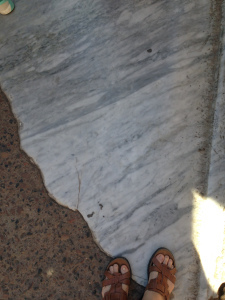
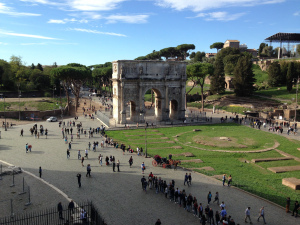
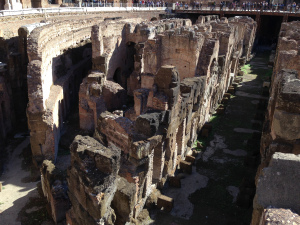
A good portion of the Colosseum can be seen without paying for a private tour, however, if you want to go below into the catacomb portion, a tour and guide is required. We arrived as the place opened and were not a part of the tour, so we walked all over the upper levels that are accessible and took lots of pictures. Upon the approach to the Colosseum, you will have the same staggering of tour companies from a good mile to half-mile from the building, all trying to garner attention and extra money. One became angry with me and yelled at me because I told my husband to ignore her. After the Vatican, I was done with the tourist trap racket.
Whether you opt for a tour guide or not, the Colosseum is definitely a must see! Just make sure you look at the little things as well.
[image error]If you’re at the Colosseum, the Arch of Constantine can’t be missed since it’s right there beside the Colosseum. The Arch was built by the Senate and dedicated in 315AD as a commemoration of the emperor Constantine’s victory at Milvian Bridge in Rome over Maxentius for control over the western portion of the Roman Empire.
The Arch is huge and made of a grey and white marble, but was technically not all original at the time the Arch was built. The eight round medallions around the building have been dated to 200 years prior to Constantine and are actually from the emperor Hadrian’s reign, some of the rectangular reliefs come from an Arch built to celebrate the victories of Marcus Aurelius (the emperor was re-carved to look like Constantine), and there are also relief sculptures that came from Basilica Ulpia in Trajan’s Forum. Even the Corinthian Columns surrounding the Arch are from another monument that no longer exists.

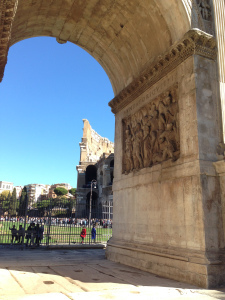
Despite it’s less than original bits and pieces 
December 13, 2017
Part 2 – The Advent Calendar
Hi, everyone! It’s time for part two of my holiday story! I’m still writing on it, so we’ll see if it’s one or two more posts. I’ll definitely let you know when the next part goes online, too 
December 11, 2017
Rome: Forum of Trajan, Trajan’s Column, Vittoriano, and more
Rome is riddled with historical monuments. I commented in the first post that you can turn a corner and find a fresco or a sculpture on the next, but it’s almost that way with monuments as well. You can turn a corner and find columns sandwiched between two buildings, or just a wall of columns that once belonged to a great building. It’s one of the most fascinating things about Rome.
The flat where we stayed had tourist maps of Rome, and I carried one around everywhere, taking us so our route crossed as many historical bits as we could. Some of these brilliant bits are on the map, but some aren’t. For example, below are two pictures. The first we crossed somewhere down by Trajan’s Forum. Nothing is on the tourist map and there are no signs to indicate what this once was, but two columns stood between old, yet newer buildings with pieces of others below. They are fenced off so no one can tamper with them.
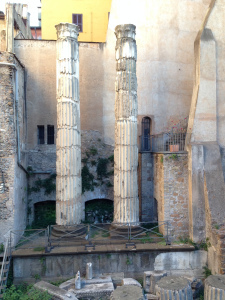
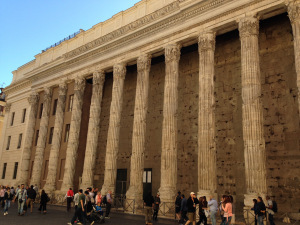
The second photo, the Temple of Hadrian, is marked on the map and is nestled in a small courtyard when you walk between the Pantheon and Trevi Fountain. The original structure was built by Antoninus Pius in 145 AD. The only bit left, this row of Corinthian columns, was added by Carlo Fontana to the plans for a 17th century papal palace. The building today, however, is not quite so lofty as it houses a bank.
Trajan’s forum was at the end of a long day, but it made it no less interesting. Designed by the architect Apollodorus, Trajan’s Forum was built in the second century and consisted of a series of markets, a temple, a basilica, and three monuments to honour Trajan. This side that is curved in a hemisphere is believed to have contained the markets of the day. There are many small rooms behind those arches that now hold more of the broken columns and pediments that are still beautiful works of art.
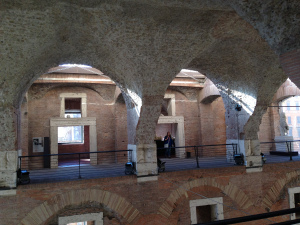
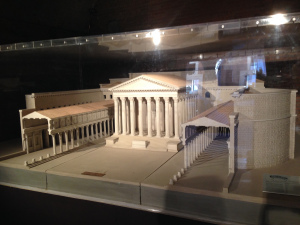
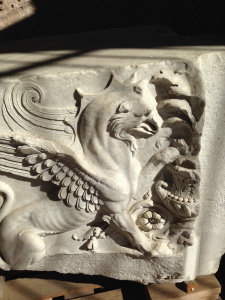
From the hemisphere of Trajan’s forum, a great view of Trajan’s column and the Vittoriano can be seen.
[image error]
Trajan’s Column
Trajan’s Column is just behind the forum and is one of several columns around the city of Rome. Trajan’s Column honours the Emperor Trajan’s defeat of the Dacians in a war from 101-106 AD, considered the “defining event” of his time in power. The relief carvings that wind up the tower depict the battle and defeat of the Dacians, which brought a “staggering” amount of riches to Rome and paid for the construction of Trajan’s Forum. The bronze statue at the top is none other than Trajan himself.
The other landmark that can be seen from the back of Trajan’s Forum, Vittoriano, is huge! Designed by Giuseppe Sacconi, this monument to Victor Emmanuel II was built between 1885 and 1911 to celebrate the first king of a unified Italy. The enormous building houses the Museum of Italian Unification, the Tomb of the Unknown Soldier, and the Shrine of the Flags.
[image error]The monument is a huge tourist attraction now, but it isn’t without its controversy. A part of the historic Capitoline Hill as well as a medieval neighbourhood were destroyed to build it. Because of the bright white colour in an area of Rome that is not white, it stands out and has earned some nicknames from the people of Rome, who still are not thrilled with its presence, including the wedding cake, the set of false teeth or la dentiera, the typewriter or macchina da scrivere and English soup dessert or la zuppa inglese.
[image error]Lastly, for today’s post is one of the first smaller bits that we stumbled upon on the tourist map. It’s called “Area Sacra” or Sacred Area. It’s fenced off and it has obviously been excavated out since it sits a bit lower than street level. It’s also surrounded by several busy streets, but is quite interesting.
In fact, its full name is Area Sacra Di Largo Argentina. Discovered in 1920, this archeological site contains the remains of temples that date back to the Republic of Rome and was once part of Campus Martius. In fact, this spot also contains the remains of Pompey’s Theatre, so nearby was the “curia” or building where Julius Caesar was killed. Frescos can be seen if you look carefully under some of the more modern constructed roofs there to protect them from the elements and if you stand there long enough, you will see a cat or two in the ruins since the site is a cat sanctuary.
Up Next… Coliseum and Palatine Hill
Sources:
http://www.turismoroma.it/cosa-fare/area-sacra-di-largo-argentina?lang=en
http://penelope.uchicago.edu/~grout/encyclopaedia_romana/imperialfora/trajan/forumtrajani.html
https://en.wikipedia.org/wiki/Temple_of_Hadrian
https://www.nationalgeographic.com/trajan-column/article.html
https://en.wikipedia.org/wiki/Altare_della_Patria


December 5, 2017
Rome: The Pantheon, Trevi Fountain, and San Carlo alla Quattro Fontane
The Pantheon was built between 118 and 125 AD on the ruins of another pagan temple, which was destroyed by fire in 80 AD. When the Pantheon was built, it was used to worship the pagan gods of Rome (though no one knows specifically which ones) until 609 when it was converted to a Catholic church by Pope Boniface IV and subsequently called Santa Maria of the Martyrs. The Pantheon also houses the tombs of Vittorio Emanuele II, Umberto I and Margherita of Savoy, as well as the renowned artist Raphael.
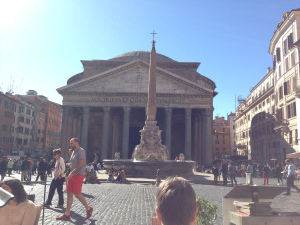
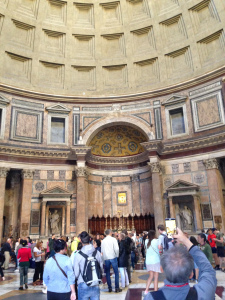
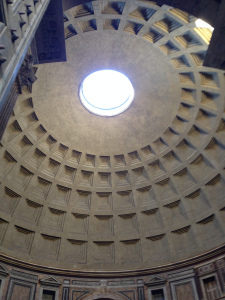
Found on the Piazza della Rotonda, a steady stream of tourists walk in and out since there is no admission to go inside. While the inside is beautiful, it is the dome of the Pantheon that is the most fascinating part of the architecture. The ancient Romans who built the Pantheon took into consideration the weight of the materials they used to build their temples since they used travertine, tufa, and pumice to construct the dome and to reduce the stress on the lower part of the building. Possibly why this amazing structure is still around and it such amazing condition.
[image error]
Ceiling and oculus
At the top of the dome is an open oculus, so when rain falls, the rain comes inside the Pantheon, but does not puddle since there are tiny holes in the flooring that leads to the old Roman pipes beneath the building. The oculus is fascinating and beautiful. It gives the inside an interesting glow when the light enters just so and adds to the draw of the dome ceiling.
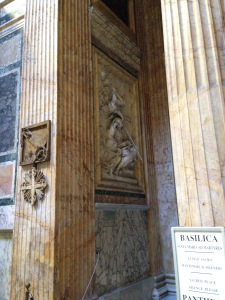

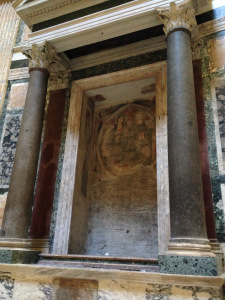
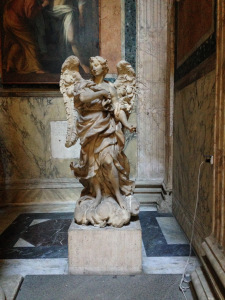
When inside the Pantheon, a huge touristy thing to do is to set your phone on a timer and take a selfie with the dome behind you. It does create a cool picture, but the angle of the sun can be problematic. Ours look more like shadows than us 
November 28, 2017
Rome: St. Peter’s Basilica
Egyptian Obelisk
According to Catholic texts, after the crucifixion of Jesus, St. Peter travelled to Rome and was martyred by being crucified head down near an ancient Egyptian obelisk in the Circus of Nero. Shrines existed in the spot until St. Peter’s was consecrated in 329 under the Emperor Constantine. During the 16th century, Pope Julius II decided St. Peter’s needed to be rebuilt rather than restored, so he brought in Donato Bramante as architect and construction started in April 1506.
Upon Bramante’s death, the project changed architects several times until Pope Paul III turned over the reins to Michelangelo. Ultimately, it took 150 years to compete St. Peter’s and Michelangelo even died before the completion of the Dome.
Regardless of the history of the building, the result is amazing! As I said in the previous post, there is a dress code, so do try to remember to wear something that covers your knees and shoulders, and no hats! They had some services going on when we were inside and one man was wearing a hat and you could see the security who noticed itching to go say something, but he was ensuring no one entered the small chapel area where the service was being held.
[image error]
Approaching in the early morning
Today, St. Peter’s Basilica is known in the art world for not only its architecture, but for three works it houses: The Pieta by Michelangelo, the baldacchino over the altarpiece and the altarpiece itself, both designed by Bernini. All three are amazing! I wanted to see the Pieta the most, but the altarpiece had to be my second favourite, particularly with the dove in the stained glass window at the top.
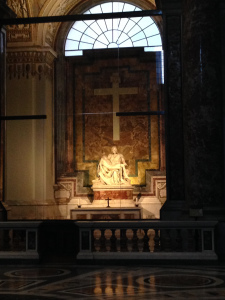
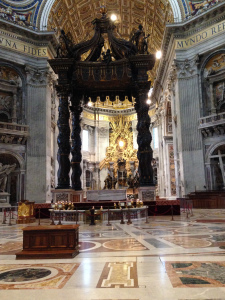
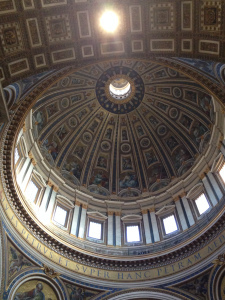
As for visiting St. Peter’s, there is substantial security. You go through security checkpoints almost like the airport before you ever enter. Then you climb up the stairs and enter through the main doors. I don’t think anything can prepare you for the sheer scale of what’s inside. It’s huge.
Directly to the right when you enter is the Pieta. Due to damage it sustained decades ago, it is protected behind glass and a protective railing that keeps the viewer much farther than I know I preferred. Mary is still just as serene though some of the smaller detailing is more difficult to see.
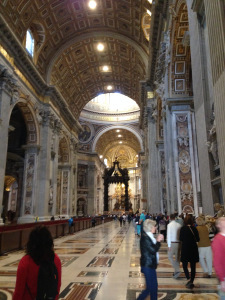

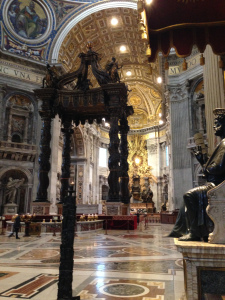
Once you pass the Pieta, it is simply a matter of walking around and just looking at all the statues, and paintings, and smaller chapels–not to mention the ceiling and the dome!! We started on that right side by the Pieta, and made a slow circle around the entirety. If you are a little photo happy like I am, be warned that sometimes if a chapel is having a service, they won’t let you photograph a sculpture or a painting in that chapel. We honestly had very few problems in St. Peter’s and my husband even managed to find a priest who took a photo of all of us together rather than us trying to take a selfie.
My biggest advice is that if you want to see St. Peter’s without a huge line/queue to get in, go within 30 minutes of it opening. When we went the Vatican the day before, the line for St. Peter’s was supposedly 2 hours. We really didn’t wait at all the next morning. According to the website, St. Peter’s opened at 7:30 and we were there by 8:00. We only had a few people before us at the security checkpoint. It was easy peasy.
There is a way to go up to the dome to see the inside, but my children were ready to walk around Rome rather than remain where we were, so we passed. Hopefully, we can go back so I can get up there!! The next day, someone told me how amazing it is. Oh well! Live and learn!
Next stop… Pantheon and a few other sites around Rome.
Sources:
https://www.lonelyplanet.com/italy/rome/attractions/st-peters-basilica/a/poi-sig/1256581/359975
http://www.vaticanstate.va/content/vaticanstate/en/monumenti/basilica-di-s-pietro/basilica.html
https://en.wikipedia.org/wiki/St._Peter%27s_Basilica


November 20, 2017
Rome: The Vatican Museums
One of the major attractions of Rome is, of course, the Vatican. The Vatican is known for having a tremendous amount of artwork as well as the Sistine Chapel, so obviously a big thing to do and see when visiting Rome. We booked tickets for the Vatican Museums for our first day in Rome. Little did we know that even during October, this would be a packed and still crazy place to visit.
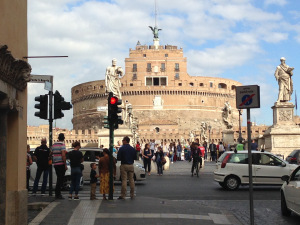

We crossed the Tiber river at Ponte Sant’Angelo, and turned left, heading towards the dome of St. Peter’s Basilica. What I didn’t expect as we turned from the bridge towards the Vatican was the immediate assault of tour guides who line the path to St. Peter’s Basilica and around to the Vatican Museums trying to sell tours. They are paced about every 10-15 steps, and all start with the same line “It’s a 2 hour wait to get into St. Peter’s! Skip the lines!” This continues as you walk to Via della Conciliazione all the way until St. Peter’s Square.
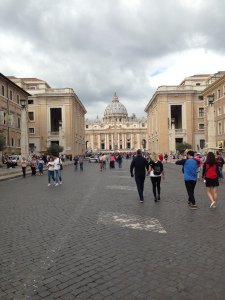
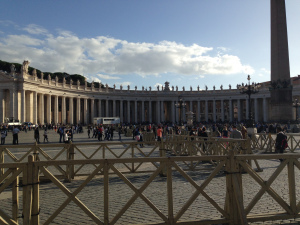
Now, a couple of things we learned from this. They have badges that say “official” but they don’t work for the Vatican or St. Peter’s Basilica. They are official to their company maybe, but they aren’t employed by the church. Most of them use the same line, but sometimes, you’ll get one tour guide who will try a different approach. With us, it was “You know you can’t go in there dressed like that!” As far as we knew, our shorts and tops were fine, but the tour companies also make a mint selling souvenir scarves for 5 to 10 euros each and try to sell you their tour in that they can provide them to you with the tour or you can purchase the scarves from their shop just to the side.
St. Peters and the Sistine Chapel do have dress codes, so if you go, simply where a top that covers your shoulders and shorts or capris that cover your knees, and you won’t require any sort of scarf. We rebelled against the tour guides and purchased them from a street vendor for the same price. I will say that even with the scarves, we didn’t put them on in the Sistine Chapel and no one said a word. They were more concerned with the photography than my shorts or my daughter’s exposed shoulders.
When the Vatican and St. Peter’s were first built, Via della Conciliazione weren’t there. Instead, a bunch of old homes and windy roads led to St. Peter’s Square and Bernini’s amazing colonnade. Mussolini was the one who tore down those old homes and paved the road creating an impressive avenue and linking Rome more indelibly to Vatican City.
Now, the Vatican Museums are almost around the back of St. Peter’s Basilica, so you have to turn right before you enter St. Peter’s Square and follow the annoying tour guides still posted regularly, around the back to the entrance. We pre-booked our tickets, so we didn’t have to wait in line except to check in for our tour time because they stagger it to keep things from becoming too packed. We showed an hour early, but we still were able to enter and begin the tour.
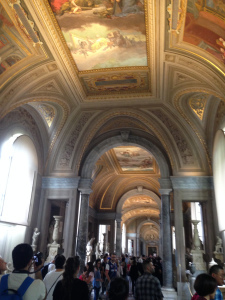
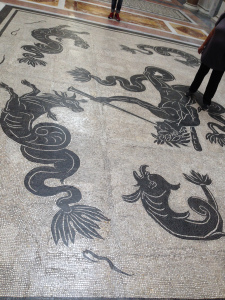
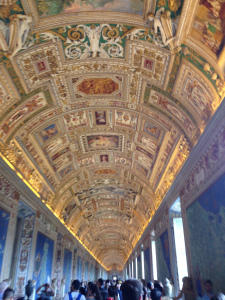
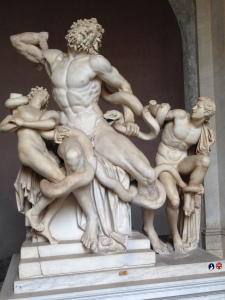
The Vatican Museums are basically a crazy winding path through various old papal apartments, rooms, and porticos all decked in amazing frescos, tapestries, and both religious and mythological statuary. It takes several hours to get all the way through and at times you have to fight crowds to see particular pieces like Laocoön and His Sons in one of the small porticos, but it’s definitely worth it.
The security and guides become more rude as you approach the Sistine Chapel. We were told to hurry through some portions until we were packed into the Sistine Chapel. It is certainly a chapel and not large–especially considering the number of people standing inside to get a look. People are supposed to remain quiet in a show of respect, so security and a recording will tell people to be quiet. Security is also calling out for people to put away their cameras and not to take photos.
The frescos and the entire atmosphere is overwhelming really. While it was beautiful, I found it a little disappointing. We all stood and looked at the ceiling for some time and then the walls before we exited and moved on to the last little bits before we exited the museums.
Unfortunately, the lines were still extremely long for St. Peter’s Basilica, so we ate a late lunch and walked around before calling it a day with the plan to be at St. Peter’s first thing when it opened. If I had to do it again, I would’ve had us get up early and be at St. Peter’s within a half hour of opening and then book the Vatican Museums a few hours later. You could put lunch between the two viewings or you could simply walk down the Tiber until your viewing time.
Next… St. Peter’s Basilica!


October 30, 2017
Rome – An Expats First Impressions
For first time travellers to Rome, we did a number of things correctly and a number of things caught us completely off-guard. Hopefully, after reading our experiences in the next several posts, you will know what to expect and won’t run across the same pitfalls we did! We still had an amazing time, so it wasn’t anything terrible, but definitely something that would’ve made things much easier if we’d known at the time.
[image error]
Ponte Sant’Angelo
We had a rather late arrival, and after reading nightmare horror stories about taxis from Ciampino airport to the city centre (which is anywhere in the Aurelian Wall), we ended up hiring a car. Yes, it was more expensive since there is a law in Rome that dictates a flat rate charge from the airport (30 euros from Ciampino and 48 from Fiumicino) for a maximum of 4 people and their luggage for licensed Taxis. It’s even posted on the outside of every taxi, but for one, we number 5 people. I’ve also read horror stories of people being dropped off at the walls or taxi drivers claiming that to the walls is the flat rate and beyond is an extra charge. The practice is illegal, but how many tourists really understand the law or are in a position to enforce it with the police if there is a problem. If it had just been me and my husband, we probably would’ve just made the attempt to get the lower price, but with three children along for the ride and the evening arrival. We weren’t willing to try.
We stayed not far from the Tiber and had a really quick walk to the Ponte Sant’Angelo when we crossed to see the Vatican. We had decided when we booked our place that we would walk everywhere and as long as you’re planning on touring what’s within the Aurelian Wall, it’s completely achievable.
So, if you’re not familiar with Rome, you might be asking ‘What is the Aurelian Wall?’. Most old cities had some sort of original wall that surrounded the city for protection and some cities still have remnants of that fortification to this day. Bath has bits of the original walls still intact around the city, though because they’re partially buried, they don’t seem much like walls; however, Rome’s Aurelian Wall, which was built by the emperors Aurelian and Probus in the 4th century still stands tall to this day. When it was first built, the entire wall, that encircled the right bank of the Tiber, was 26 feet high, surrounded 12 square miles, had 383 towers, 18 main gates, and over 2,000 windows.
When you approach the walls, even at night, you can’t miss them. We passed through one of the gates, which is one lane, and once we were inside, the traffic became even crazier before. If you’ve never driven in Rome before, you’re in for a shock! As opposed to British drivers, who tend to be rather mannerly on the road and rarely use their horn, the Italians are the opposite. Everyone uses their horn, they cut each other off, and then squeezing through tight spaces–I thought we’d never make it in a couple of places.
Arriving at night was fascinating and beautiful, though. We passed by so many historical places that were illuminated and looked just amazing in the dark.
Once we were shown around where we were staying by the property owner (We had the same experience in Venice as well. They took us around the entire flat and showed us everything.), we needed to eat. With several of us requiring gluten-free, that can always be a struggle, but my daughter found a place with 4 stars on Google, so we headed in that direction.
Voglie di Pizza is not large and it’s not the fanciest place when you look at it. It’s not much more than a narrow strip of hallway inside with outdoor seating, but it was one of our favourite places to eat by the time we left. We even returned on our last night. For those who need gluten-free, there is a regular menu as well as a decent gluten-free menu. A lot of places will only have pizza or only have pasta, but they also had Melanzane Alla Parmigiana (Eggplant/Aubergine Parmesan) and a few other options as well. I also had Tiramisu, which is something I haven’t had in forever. The food was good, the prices were not as high as a lot of places, and the people who worked there were extremely friendly and helpful. Definitely a recommend if you’re in the area!
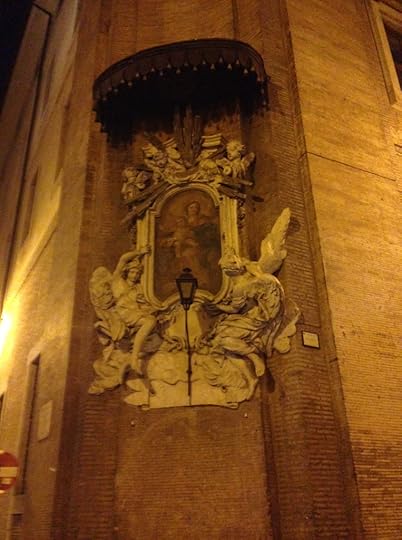
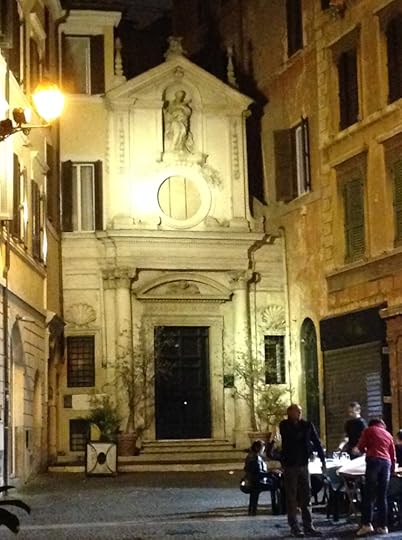
We ended our first evening in Rome with a leisurely walk back to the flat so we could start sight-seeing the next day. It’s amazing all the little things on random street corners whether it’s statues or paintings, and then the churches tucked up into little niches along narrow cobbled streets. It’s definitely worth seeing!
Next post… the Vatican and St. Peter’s Basilica
Sources:
https://en.wikipedia.org/wiki/Aurelian_Walls


October 23, 2017
Bruges, Belgium
For those who haven’t been, Bruges is lovely–and I’ve only seen a portion of it! Bruges is a combination of lovely old cobbled streets, well-preserved buildings, and waterways. The city centre is even enough to be made a UNESCO World Heritage Site and sometimes called “The Venice of the North.”
Historically, Bruges is first heard of in the 9th century and was probably first a coastal settlement, though by the 19th century it was a destination for well-to-do French and British tourists.

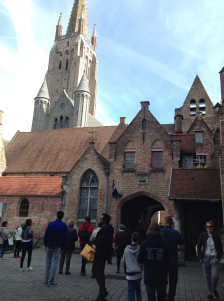
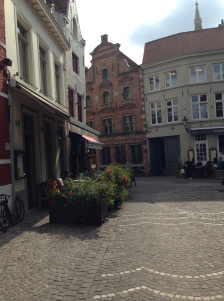
We left Mons with the intention of stopping in Brussels, but leave it to us to pick the one day of the year Brussels is closed to cars!!! Bruges was only an hour away, so we detoured in that direction since it wasn’t too far from the Calais. We found inexpensive parking at the train station and then with the help of a friendly local, we passed through the train station and in the direction of the city centre.
Bruges, in some ways a lot like the Netherlands, has bike paths, so make sure you don’t stand in them when looking to cross the street or you will have some rather angry locals and you might just get run over! 
October 16, 2017
Mons, Belgium
The first signs of people in Mons date back to the Neolithic period, but wasn’t made a town until the 12th century. Though in its early days, it was a mining town, it has changed dramatically. Since that time, this city near the French border has also grown, though still not the size of Brussels.
We had a few hours one afternoon while visiting a nearby village and decided to go into Mons and see what was there. Our first views were typical of many towns or cities in Northern Europe until we turned a corner to find a sculpture shadowing the road. On rue de Nimy, an enormous arrangements of sticks was designed by artist Arne Quinze. You drive through on the street below.
[image error]
We found parking on a side street. When we paid, we thought we put in money for 3 hours, but it turned out that we covered our parking until the next morning. After shrugging it off and putting the ticket in our window, we walked until we happened upon a church. I always love to look around the churches here, so we stepped inside.
Sainte Elisabeth has had several churches since people first began worshipping there, but the latest Baroque structure was built in the 18th century. It was a lovely church and definitely worth the walk through with the 16th, 17th, and 18th century artwork inside as well as the architecture.
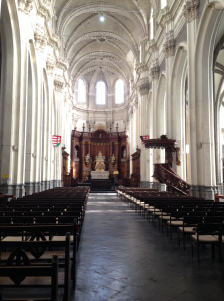
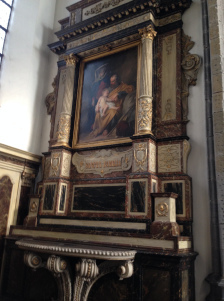
When we departed Sainte Elisabeth, we continued down rue de Nimy until we reached Grand Place. Most towns in this region have a Grand Place as it was their market centre and most still remain with quaint restaurants with outdoor tables and great architecture. In this case, it was no different.
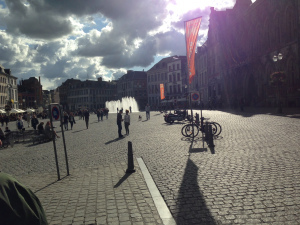
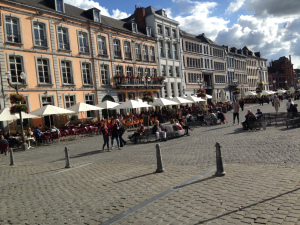
We continued on until we hit the end of the pedestrian only roads and then doubled back. My son was aching for a waffle, so we stopped at a small stand to indulge his whim. They aren’t quite the same as in Brussels, where they are a waffle smothered in fruit, whipped cream, chocolate, and all other forms of the decadent, but a simple glazed sort of waffle you held in a piece of paper and if you wished, they shoved long strips of chocolate into the thicker parts.
We couldn’t resist but to duck into a store with the sign Fromagerie. If you don’t like the smell of aged cheese, you won’t care for the smell of this store. They had an amazing selection, though, and we ended up buying some beer cheese for my husband and apple cheese for the rest of us that I apparently ate way too much of, much to the dismay of my daughter.
Of course, we couldn’t have cheese without bread and a bakery next door had baguettes as well as an amazing seeded gluten free loaf I couldn’t resist trying. We stopped at a local grocery store for some more gluten free goodies and a bottle of wine (to go with the cheese and bread of course!!!) before heading back to the quaint farmhouse where we were staying.
[image error]
Our friends in Belgium 
September 26, 2017
King’s College Chapel – Cambridge
If you’ve never been inside King’s College Chapel in Cambridge, then by all means go! We made an attempt two years ago, but we were told they’d changed the viewing hours to one day a week at that time and we were unable to see inside. This time, we travelled to Cambridge for a Jane Austen exhibit in the library, but traffic had us arrive too late. Fortunately, the chapel was still open and we decided to do that instead.
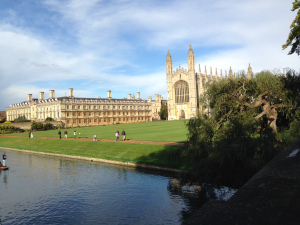
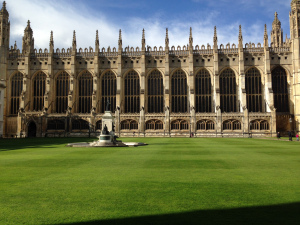
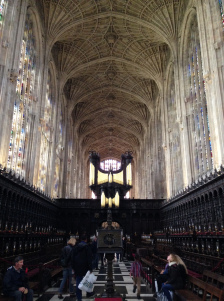
The initial building of King’s Chapel began on 25 July 1446 by Henry VI and took over one hundred years to finish. In the process, Henry flattened a good portion of what existed as Cambridge–houses, shops, and wharves–to clear enough land for the scale of the project. He wanted King’s College Chapel to be without equal in terms of its grandeur and beauty. There was supposed to be much more than the chapel by Henry’s plans. He desired more of a court, but he died before it could be completed, and despite instructions left in his will, only the chapel was built.
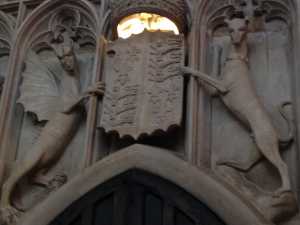
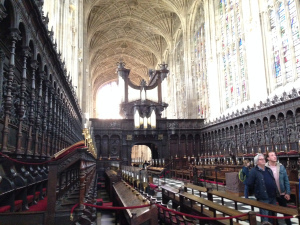
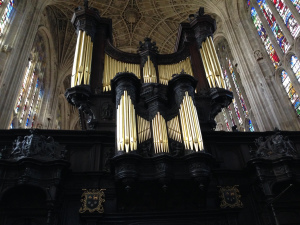
King’s Chapel is an amazing example of Gothic (Perpendicular) architecture with the largest fan vault in existence. A great deal of the stained glass also dates to medieval times and if you look closely, you can see the difference between the older glass and the newer by the detail of the figures and faces.
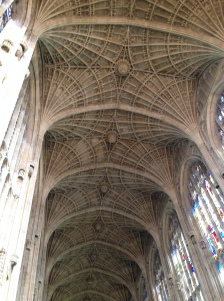
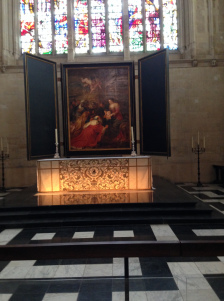
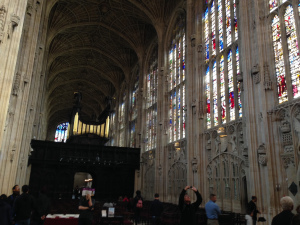
Carvings in the wall are all representative of the Tudors, from the Tudor Rose to the dragons and the greyhounds on Henry VII coat of arms. The greyhound represented Henry’s mother, who was a Beaufort, and the dragon the Tudors while a fleur de lis is present to represent his “titular kingship of France.”

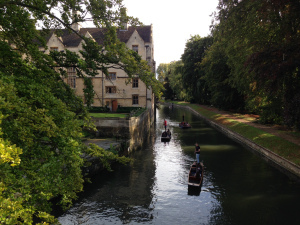
If you go, also don’t miss the Adoration of the Magi by Rubens on the altarpiece. The altarpieces in Europe have some amazing artwork and this one is no different. We also were able to walk the grounds after since it was an open day at the college. I definitely recommend it if you have the opportunity. Unfortunately, the other buildings are closed to the public.
Sources:
http://www.kings.cam.ac.uk/chapel/index.html
http://www.kings.cam.ac.uk/chapel/history.html
http://www.cam.ac.uk/research/features/going-to-the-dogs-the-500-year-old-greyhounds-of-kings-and-in-the-fight-against-cancer





